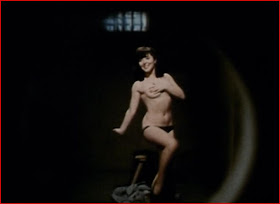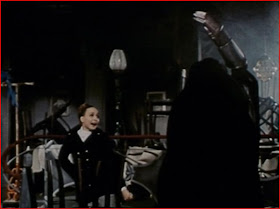 While no equal to its erstwhile Axis partner Italy in the generation of cinematic genres and subgenres, Germany has cultivated its own national styles and genres, from the globally-influential expressionism of its silent films to the question-begging "New German Cinema" of the Seventies and Eighties. The Germans' most distinctive contribution to the global grindhouse of pop cinema may be the krimi, a genre of crime film as much inspired by a foreign writer (England's Edgar Wallace, a co-author of King Kong) as by national traditions (Dr. Mabuse, etc.) Krimis usually deal with some sort of supercriminal or gang pitted against the intrepid investigators of Scotland Yard -- an Italian tendency to set numerous gialli and other horror films in England may reflect a krimi influence. The German films have several distinctive features, the most prominent arguably being the use of loud, jazzy or loungy soundtracks that give them a dated quaintness today -- and the frequent participation of rising star Klaus Kinski.
While no equal to its erstwhile Axis partner Italy in the generation of cinematic genres and subgenres, Germany has cultivated its own national styles and genres, from the globally-influential expressionism of its silent films to the question-begging "New German Cinema" of the Seventies and Eighties. The Germans' most distinctive contribution to the global grindhouse of pop cinema may be the krimi, a genre of crime film as much inspired by a foreign writer (England's Edgar Wallace, a co-author of King Kong) as by national traditions (Dr. Mabuse, etc.) Krimis usually deal with some sort of supercriminal or gang pitted against the intrepid investigators of Scotland Yard -- an Italian tendency to set numerous gialli and other horror films in England may reflect a krimi influence. The German films have several distinctive features, the most prominent arguably being the use of loud, jazzy or loungy soundtracks that give them a dated quaintness today -- and the frequent participation of rising star Klaus Kinski.Die Blaue Hand, directed in lurid color by krimi specialist Alfred Vohrer, is a Kinski showcase. He's being sentenced for murder as the film opens -- or rather, Dave Emerson is until the respected, monocled Dr. Mangrove (Carl Lange) informs the court that Dave is insane and requires hospitalization. The court so rules, provoking Dave to prove both his innocence and his sanity by leaping out of his box and screaming at the judge. How can you say no to that? All the while, another Kinski watches -- this is Dave's twin brother Richard. Unfortunately, Vohrer's effects budget limits our chances to experience the certain madness of two Kinskis on screen simultaneously.
Subdued, Dave is in a police van awaiting transport to Mangrove's asylum when someone tosses a key inside. Dave has no idea who did this, but he isn't questioning his good fortune either. That night, he breaks out of the asylum and heads for the Emerson mansion, where he gets past an exiting Richard and holes up in his brother's bedroom. Is it a coincidence that, at the same time, a hooded figure sporting an armored, spiked (and yes, blue) gauntlet starts punching people to death at the mansion? It is an old family heirloom, after all.
"You see? It's blue!"
A typical heroic inspector (top-billed Harald Leipnitz) is soon on the case, visiting the Mangrove asylum and inspecting the remaining inmates. This means a literal peepshow view of an insane stripper who apparently suffers from what we might call interpretive insanity. That is, she interprets her insanity by stripping. Nothing else is quite that interesting, though there's also one of those big, bald, stupid looking fellows who are often up to no good in krimis, sitting quietly for the moment in his cell.
The investigation moves on to the Emerson place, where the inspector quickly figures out that the man passing himself off as Richard is actually Dave the fugitive, who has cleaned and dressed himself and exploited the fact that no one in his family -- a mother, two younger brothers and a sister -- can tell the twins apart. The inspector also realizes that Dave is innocent of one thing at least, since die blaue Hand attacks the Emerson girl while Dave is standing in front of him. Now the inspector is willing to entertain Dave's story of a larger frame-up, especially if Dave can help him stop the gent with the gauntlet from wiping out the other Emersons. Richard is already presumed missing, and in short order the two remaining brothers are dispatched, while the brave and comely Myrna (Diana Koerner) undertakes an investigation of her own.Dr. Mangrove's controversial strip therapy concept was denounced in
his time, but he could probably make millions with it today.
The good guys eventually discover a conspiracy to wipe out the Emerson children and frame Dave for it. Dr. Mangrove is a willing collaborator; his asylum is no more than a dumping ground for people who want to be rid of inconvenient relatives. He'll declare anyone insane for a price, and he'll keep people in line with drugs and torture if necessary. He has his own orwellian Room 101 full of rats and snakes to scare victims like Myrna into compliance if she can't be rescued in time. The mystery, if that's the right word for it, is who's paying Mangrove and having the kids killed. The deeper mystery is why someone needs to parade about in a cloak and use a mailed fist to kill them, but let's indulge the krimi genre in its eccentricities.
After that characteristic opening scene, Kinski may actually be the biggest disappointment of the film. Since Dave is soon established as one of the heroes, and Richard is absent for most of the picture, the great man doesn't really have many opportunities to do his crazy thing. The idea of twin Kinskis should have resulted in something amazing in its own right, but Creature with the Blue Hand probably never meant to be that film.You can't get much more evil than Karl Lange's Dr. Mangrove -- but what if you add snakes???
Fortunately, Die blaue Hand is a pretty wild movie on its own terms. It crams a lot of bizarre digressions into a mere 74 minutes, not counting some stuff reportedly inserted after the fact by an American distributor. You get a room full of hanging mannequins, a butler who reveals himself as the disgruntled ex-husband of the Emerson materfamilias, and a second inspection of the insane stripper, on top of everything I've already mentioned. If Kinski recedes during the story, Karl Lange emerges as an awesome looking villain in the Germanic Caligari tradition of evil asylum keepers, while Diana Koerner makes Myra an appealing heroine. Visually, even in something well short of restored form, Hand looks great in moody, Bava-influenced color, and the admitted datedness of the music is a point in the film's favor as far as I'm concerned. However faithful he may or may not be to Edgar Wallace, Vohrer came up with a vivid modernized mix of the Mabusian crime tradition and the American "old dark house" style. A film like this was probably campy when it first appeared, but if you can tolerate its absurdities you'll probably be as entertained by this brisk adventure as I was.







I love those German krimis. Stylish B-movies with a flavour all their own.
ReplyDeleteThe Dr Mabuse movies from the early 60s are worth seeing as well. Fritz Lang revived the character with The 1,000 Eyes of Dr Mabuse in 1960 and it was followed by several others by different directors. But they'e all fun, and if you like the Wallace krimis you should like them as well.
1000 Eyes was a great way for Lang to go out, and I've also seen a U.S. cut of The Return of Dr. Mabuse, which was fun not least for hearing the dubbed voice commanding the villain's mind-controlled army to obey "Doctor Mabooze." That's how I thought the name was pronounced back when I was a kid, knew no German whatsoever, and had only seen the name in silent films.
ReplyDeleteSamuel, I agree, it was a great finish to Lang's career. And very fitting that he ended his career with another revisit of the immortal Dr Mabuse character.
ReplyDelete